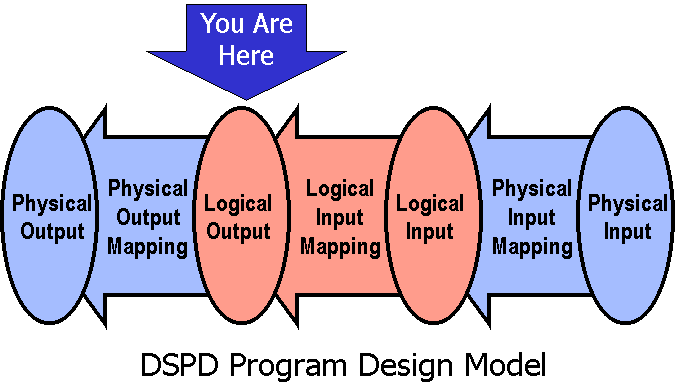
| Dave Higgins Consulting Strategic Technology Consulting and Enterprise Architecture |
Home | What's New | What's Old | Articles | Associates | Interesting Links | Cool Stuff |
Logical Output Structures
Introduction
The creation of the Logical Output Structure (LOS) is the first
of seven steps in program design.

Step One: Create a Warnier/Orr diagram depicting the structure of the output independent of the input and output devices. This Logical Output Structure can be built from information gathered on the Output Definition Form: the Output Frequencies listed become the hierarchy shown on the LOS; the Data Elements listed become the data features shown on the LOS.
An Example... Consider the following output prototype...
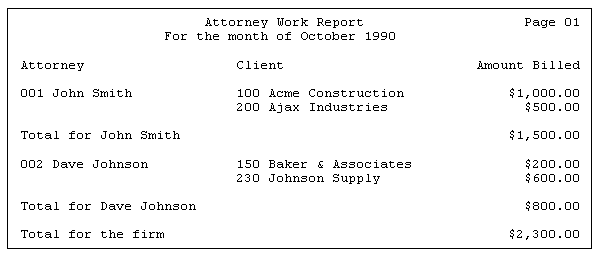
Developing the LOS There are three groupings of logical data on this output. The group (enclosed in the box below) representing all the data on the output (data for the Firm)...
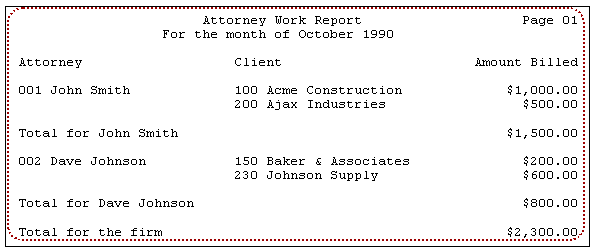
The groups representing data about each Attorney...
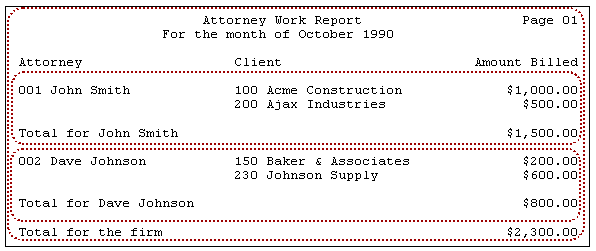
And the groups representing data about each Client...
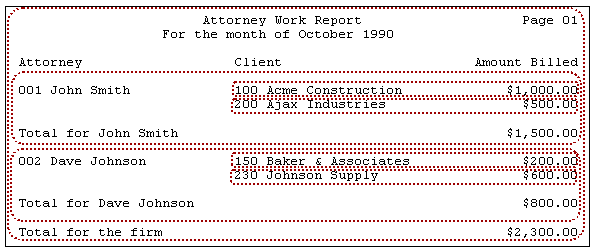
The LOS Hierarchy As this output has three groupings of data, one would expect to find three levels of hierarchy on its Logical Output Structure. They are...
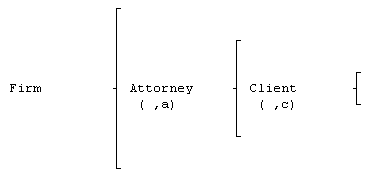
The Client level repeats within Attorney; the Attorney level repeats within Firm.
Next, the minimum bounds for each repetitive level must be determined.
For the Attorney level: the number of times beneath the Attorney set indicate the number of Attorneys to be listed for the Firm. As such, it will either be "0,n" if the output for the Firm could list no Attorneys, or "1,n" if the output for the Firm must list at least one Attorney. Typically, this determination takes the form of a question for the client "Is the output for the Firm produced even when no Attorneys did any work for the period?" An answer of yes means that the output could contain information about "0,n" Attorneys. If the answer is no, that means the output is always to contain information about at least one Attorney.
For the Client level: the number of times beneath the Client set refer to the number of Clients to be listed on the output for any one Attorney on the output. Again, asking the question "would an Attorney with no Clients be listed on the output" can determine the proper minimum bound: yes means that any given Attorney can have information listed about "0,n" Clients; no means that each Attorney on the output will list at least one Client.
Based on the responses to the above questions, the minimum bounds are filled in.

The LOS Data Once the hierarchy has been established, the logical data elements present on the output are placed on the diagram in the appropriate location.

If the Output Definition Form was done prior to the construction of the LOS, the Data Elements listed can be added to the hierarchy easily...
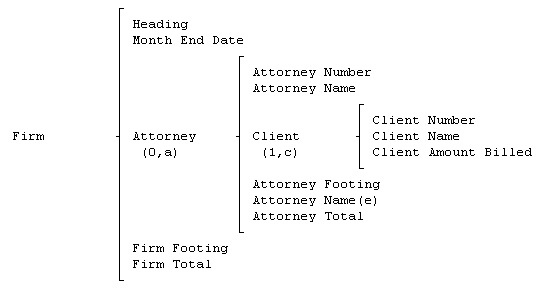
Tips
and Hints
When developing Logical Output Structures, there are several
things to keep in mind...
Finally, notice that Logical Output Structures reflect the data in its "natural" or most logical sequence. In other words, if the actual output has data in an unnatural or inconvenient sequence, the LOS shows the data in the order in which it should be naturally processed. Tax forms, for instance, are notorious in their non-linear presentation of data--the Logical Output Structure, however, would show the tax data in the sequence it should be produced. (Remember that the Physical Output Mapping--the part of the program which is in charge of formatting the output--can package the logical output in a different sequence or in a different format). Thus, for an output like a tax form, its LOS will show the data in the order that the form is filled out (line 1, line 38, line 27, and so on) rather than the order in which the data is listed.
Repetition
on Outputs
Repetition occurs on outputs whenever, as in the first example,
the same set of data appears multiple times within another set.
Sometimes, a set may contain multiple repeating levels. For
example...
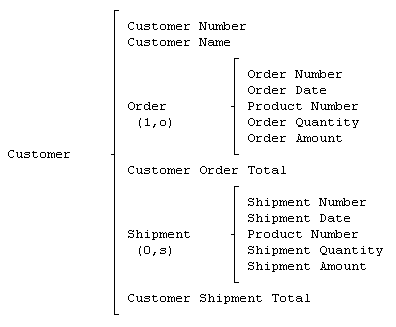
would be shown on the LOS if, for one Customer, multiple orders were listed followed by multiple shipments.
Repetition may occur for the same set at different levels, as well. Consider the LOS for a generic "spreadsheet."

Not only are there one to many Amounts shown each row, there may be one to many Column Headings shown at the top of the spreadsheet, and one to many Column Totals shown at the bottom of the spreadsheet.
Alternation
on Outputs
Alternation occurs on an output whenever some data either appears
or does not appear for each member of a group. For instance,
consider the following output...

For salaried employees, their salary is listed in addition to their number and name. For hourly employees their hours, rate, and pay are listed. This is shown on a Logical Output Structure as follows.
Notice that the Logical Output Structure shows the Employee Number and Name at the Employee level (since they are shown for every Employee).
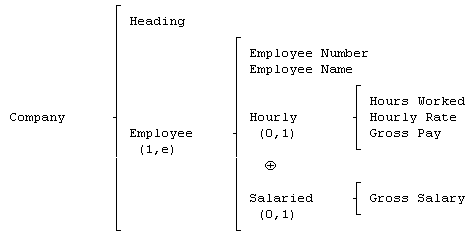
The exclusive Or construct says that any one Employee is either Hourly or Salaried, and shows the data that will be found on the output for each type.
Home | What's New | What's Old | Articles | Associates | Interesting Links | Cool Stuff |
This web site and all
material contained herein is Copyright ©2002-2009 Dave
Higgins. All Rights Reserved. For additional information,
please contact me at: |